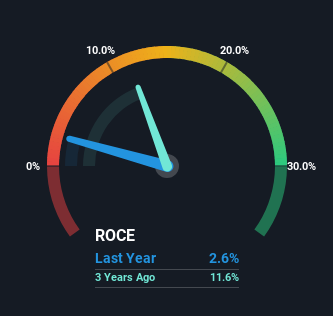- China
- /
- Tech Hardware
- /
- SZSE:300956
Some Investors May Be Worried About Anhui Shiny Electronic Technology's (SZSE:300956) Returns On Capital
If we want to find a stock that could multiply over the long term, what are the underlying trends we should look for? In a perfect world, we'd like to see a company investing more capital into its business and ideally the returns earned from that capital are also increasing. Basically this means that a company has profitable initiatives that it can continue to reinvest in, which is a trait of a compounding machine. However, after investigating Anhui Shiny Electronic Technology (SZSE:300956), we don't think it's current trends fit the mold of a multi-bagger.
What Is Return On Capital Employed (ROCE)?
Just to clarify if you're unsure, ROCE is a metric for evaluating how much pre-tax income (in percentage terms) a company earns on the capital invested in its business. To calculate this metric for Anhui Shiny Electronic Technology, this is the formula:
Return on Capital Employed = Earnings Before Interest and Tax (EBIT) ÷ (Total Assets - Current Liabilities)
0.026 = CN¥39m ÷ (CN¥2.5b - CN¥1.0b) (Based on the trailing twelve months to March 2024).
Thus, Anhui Shiny Electronic Technology has an ROCE of 2.6%. Ultimately, that's a low return and it under-performs the Tech industry average of 5.3%.
See our latest analysis for Anhui Shiny Electronic Technology

While the past is not representative of the future, it can be helpful to know how a company has performed historically, which is why we have this chart above. If you want to delve into the historical earnings , check out these free graphs detailing revenue and cash flow performance of Anhui Shiny Electronic Technology.
What Can We Tell From Anhui Shiny Electronic Technology's ROCE Trend?
In terms of Anhui Shiny Electronic Technology's historical ROCE movements, the trend isn't fantastic. Over the last five years, returns on capital have decreased to 2.6% from 19% five years ago. Although, given both revenue and the amount of assets employed in the business have increased, it could suggest the company is investing in growth, and the extra capital has led to a short-term reduction in ROCE. If these investments prove successful, this can bode very well for long term stock performance.
On a related note, Anhui Shiny Electronic Technology has decreased its current liabilities to 40% of total assets. That could partly explain why the ROCE has dropped. Effectively this means their suppliers or short-term creditors are funding less of the business, which reduces some elements of risk. Since the business is basically funding more of its operations with it's own money, you could argue this has made the business less efficient at generating ROCE. Keep in mind 40% is still pretty high, so those risks are still somewhat prevalent.
The Bottom Line
Even though returns on capital have fallen in the short term, we find it promising that revenue and capital employed have both increased for Anhui Shiny Electronic Technology. These trends don't appear to have influenced returns though, because the total return from the stock has been mostly flat over the last three years. So we think it'd be worthwhile to look further into this stock given the trends look encouraging.
On a final note, we've found 2 warning signs for Anhui Shiny Electronic Technology that we think you should be aware of.
While Anhui Shiny Electronic Technology isn't earning the highest return, check out this free list of companies that are earning high returns on equity with solid balance sheets.
New: Manage All Your Stock Portfolios in One Place
We've created the ultimate portfolio companion for stock investors, and it's free.
• Connect an unlimited number of Portfolios and see your total in one currency
• Be alerted to new Warning Signs or Risks via email or mobile
• Track the Fair Value of your stocks
Have feedback on this article? Concerned about the content? Get in touch with us directly. Alternatively, email editorial-team (at) simplywallst.com.
This article by Simply Wall St is general in nature. We provide commentary based on historical data and analyst forecasts only using an unbiased methodology and our articles are not intended to be financial advice. It does not constitute a recommendation to buy or sell any stock, and does not take account of your objectives, or your financial situation. We aim to bring you long-term focused analysis driven by fundamental data. Note that our analysis may not factor in the latest price-sensitive company announcements or qualitative material. Simply Wall St has no position in any stocks mentioned.
About SZSE:300956
Anhui Shiny Electronic Technology
Engages in the research, development, design, production, and sales of consumer electronic product structural parts modules and related precision molds in China and internationally.
Adequate balance sheet with low risk.
Market Insights
Community Narratives



